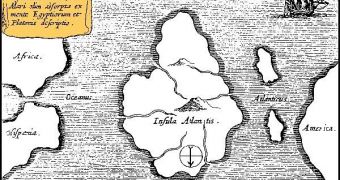The Greek historian and philosopher Plato represents the only Ancient account of the existence of the mythical island of Atlantis. In other words, any other evidence or tale about the “sunken island” is, in one way or the other, connected to the historian's writings. Now, experts analyzing the small circular archipelago of Santorini, which is some 200 kilometers southeast of Greece, believe that they may have found an explanation for why the Greek scholar said that Atlantis was swallowed by the waves.
They argue that, sometime between 1630 B.C. and 1550 B.C., during the Bronze Age, a massive eruption took place on Santorini, which was at the time a single island. The burst was so massive, that it essentially fragmented the islands in the pieces that can still be seen today, and sunk all the rest. Scientists believe that this eruption, which is one of the largest in human antiquity, may have generated a massive tsunami that traveled as far as Israel and spawned the accounts that Plato gave of the supposedly sinking of the island-state Atlantis.
The killer wave may have also brought about the demise of the Minoan civilization, which was at the time dominating the Mediterranean Sea area. However, the exact effects that the eruption had on their society have largely remained a mystery for decades. Using modern investigation methods, researchers determined that the tsunami kicked up by the volcanic eruption traveled in a radius up to 600 miles (1,000 kilometers) around the initial blast zones, leaving foot-thick layers of deposits on coast lines.
In their experiments, conducted off the coast of Caesarea, in Israel, experts collected 6-foot (2-meter) sediment samples from a depth of 65 feet, or 20 meters. “The work resembles a construction site with pneumatic hammers, heavy weights, floats to counter-weight equipment, hoses. Each time we took the system down it took hours of surface preparation, planning, and discussion,” says Interuniversity Institute for Marine Sciences marine geoarchaeologist Beverly Goodman, from Eilat, Israel.
“I was testing how two later Roman and Byzantine tsunami deposits could be characterized by studying the different grain sizes – various sand, pebbles, rocks, ceramic pieces – in the deposit. Based on determining this 'signature,' I then noticed that there were more than the expected number of tsunami deposits. I had no expectation that remnants of the Santorini event would be present in the cores,” she adds, quoted by LiveScience.
In spite of the fact that Atlantis remains “a myth and [a] legend, it is informative about the experiences of the ancients. It may very well be the case that those passing the story on had heard of or witnessed events in which coastal buildings went underwater because of earthquakes; beachfront towns were flooded during tsunamis; islands were created by underwater volcanic activity. There may be that grain of truth that lent legitimacy and a certain reality to the legend of Atlantis,” the expert concludes.

 14 DAY TRIAL //
14 DAY TRIAL // 
